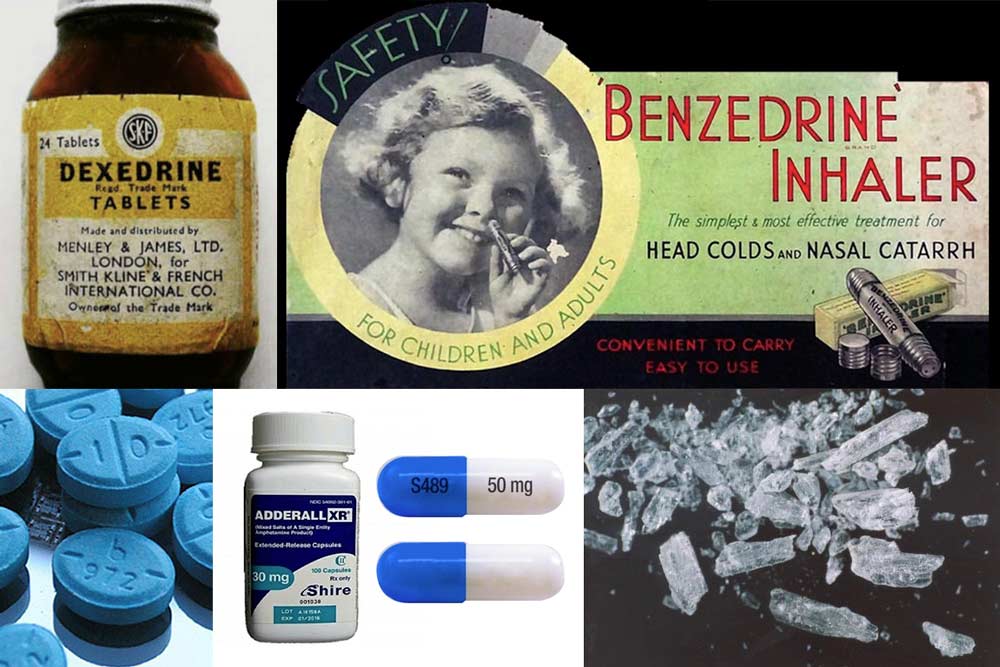The first amphetamine was developed in 1887 by Romanian chemist Edeleano and became commercially available in the 1930s under the brand name Benzedrine. Initially used as an inhaler for nasal congestion, it quickly gained attention for its ability to treat narcolepsy and ADHD when it became available in tablet form by 1937.
What are Bennies?
Benzedrine, often referred to as bennies, was once celebrated for its versatility in treating various conditions, but its widespread misuse led to significant health concerns. Appearing in literature, music, and pop culture, Bennies became synonymous with stimulant use during their peak popularity from the 1930s to the 1960s. Before stricter FDA regulations, Benzedrine was widely available and extensively abused.
According to Brittanica, “Benzedrine was issued by the U.S. government to soldiers during World War II to increase vigilance and energy. It was also popularized for treating depression, weight loss, and fatigue in civilian life.”
Benzedrine Through the Ages
As the first brand-name amphetamine, Benzedrine played a significant role in medicine and culture:
- Widely used to combat fatigue and maintain focus in the 1930s.
- Prescribed to soldiers in World War II for alertness and morale.
- Promoted in the 1950s as a diet aid and mood enhancer for housewives.
- Embraced by the Beatnik movement in the 1960s for its stimulant properties.
How Benzedrine Was Abused
While initially marketed for medical use, Benzedrine inhalers and tablets became popular for their stimulant effects. Users often misused inhalers by dismantling them to consume the amphetamine-soaked paper strips inside. This led to heightened stimulant effects, contributing to its eventual FDA ban in 1959.
“During the mid-20th century, Benzedrine became a symbol of both medical advancement and the darker realities of unchecked pharmaceutical use. Its widespread misuse highlighted society’s growing reliance on stimulants to fuel productivity and escapism,” explained Dr. Charles Rosenberg, a historian specializing in the history of medicine at Harvard University.
Why Did Benzedrine Use Decline?
By the 1960s, the addictive potential and severe side effects of Benzedrine, such as psychosis and cardiovascular issues, became widely recognized. Its classification as a Schedule II controlled substance under the 1971 Controlled Substances Act marked the end of its widespread availability and unregulated use.
“By the 1960s, Benzedrine’s rise and fall mirrored a broader societal reckoning with the dangers of stimulant abuse,” said Dr. David Courtwright, a historian and author specializing in the history of drug use. “Its reclassification under the Controlled Substances Act symbolized a turning point in how America addressed the balance between medical utility and addiction risks.”
Understanding ‘Bennies’ Today
Though the term “bennies” evokes the historical context of Benzedrine, amphetamines continue to play a role in modern medicine:
- Adderall and Vyvanse are modern prescription medications derived from amphetamine compounds.
- These medications are used to treat ADHD, narcolepsy, and other conditions.
- Street drugs like crystal meth share chemical similarities with Benzedrine, highlighting its lasting influence on stimulant drug development.
What Is Benzedrine Used For Today?
Although Benzedrine itself is no longer available, its active ingredient, amphetamine, is still prescribed under strict regulation for medical conditions like ADHD, binge eating disorder, and narcolepsy.
Amphetamine Addiction Treatment at Still Detox
Amphetamine abuse remains a pressing concern, with many individuals struggling with addiction to prescription medications like Adderall or illicit substances like crystal meth. At Still Detox in Boca Raton, Florida, we provide specialized treatment for amphetamine addiction, offering comprehensive care to support long-term recovery.
Call us today at (561) 556-2677 to learn more about our treatment programs and start your journey to recovery.
Is Adderall a Benzedrine?
Although Adderall and Benzedrine share a common ingredient—amphetamine—they differ significantly in formulation and application. While Benzedrine’s unregulated use led to widespread abuse, modern amphetamines like Adderall are carefully regulated but still carry the risk of addiction. Understanding this history helps contextualize the ongoing challenges of amphetamine use and misuse.








